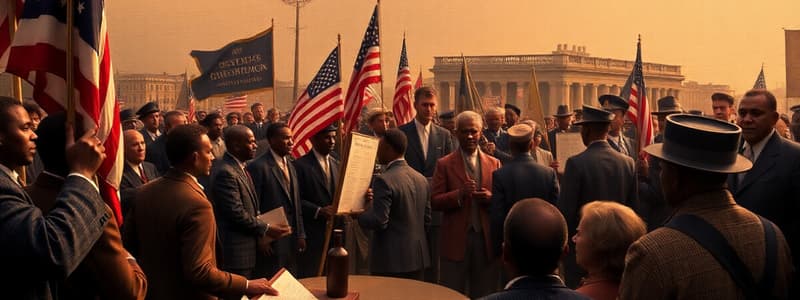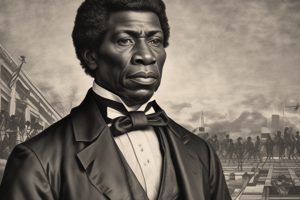Podcast
Questions and Answers
What is the main purpose of civil rights?
What is the main purpose of civil rights?
To ensure equal treatment and protection under the law.
Name one thing the Civil Rights Movements fought for.
Name one thing the Civil Rights Movements fought for.
Rights of minorities who faced discrimination
In the Dred Scott case, who was Dred Scott?
In the Dred Scott case, who was Dred Scott?
A slave
According to the Dred Scott Supreme Court decision, why was Dred Scott unable to sue?
According to the Dred Scott Supreme Court decision, why was Dred Scott unable to sue?
Which event did the Dred Scott decision help push the nation closer to?
Which event did the Dred Scott decision help push the nation closer to?
Which amendment abolished slavery in the entire United States?
Which amendment abolished slavery in the entire United States?
The 14th Amendment ensured the Bill of Rights applied to which group of people?
The 14th Amendment ensured the Bill of Rights applied to which group of people?
What did the 15th Amendment secure for Black men?
What did the 15th Amendment secure for Black men?
What was the expectation that arose out of the Black/Slave codes?
What was the expectation that arose out of the Black/Slave codes?
What did vagrancy law make illegal for Black people?
What did vagrancy law make illegal for Black people?
What did Black Codes restrict regarding property and business?
What did Black Codes restrict regarding property and business?
In Plessy v. Ferguson, what kind of segregation specifically was found to be constitutional?
In Plessy v. Ferguson, what kind of segregation specifically was found to be constitutional?
What legal precedent did Plessy v. Ferguson establish?
What legal precedent did Plessy v. Ferguson establish?
Which era saw the implementation of Jim Crow laws?
Which era saw the implementation of Jim Crow laws?
Give one example of a public facility segregated under Jim Crow laws.
Give one example of a public facility segregated under Jim Crow laws.
What was the aim of literacy tests used during the Jim Crow era?
What was the aim of literacy tests used during the Jim Crow era?
What did the grandfather clause allow?
What did the grandfather clause allow?
What did the poll tax require individuals to pay to do?
What did the poll tax require individuals to pay to do?
Which amendment outlawed the poll tax in federal elections?
Which amendment outlawed the poll tax in federal elections?
What right did women gain from the 19th amendment?
What right did women gain from the 19th amendment?
What did women hope to vote on with the right to vote?
What did women hope to vote on with the right to vote?
In Brown v. Board of Education, what specifically was challenged?
In Brown v. Board of Education, what specifically was challenged?
Which Supreme Court case did Brown v. Board of Education overturn?
Which Supreme Court case did Brown v. Board of Education overturn?
What was ruled unconstitutional in Mendez v. Westminster?
What was ruled unconstitutional in Mendez v. Westminster?
What did Virginia law prohibit that led to the Loving v. Virginia case?
What did Virginia law prohibit that led to the Loving v. Virginia case?
Which amendment did the Supreme Court say was violated in the Loving vs. Virginia case?
Which amendment did the Supreme Court say was violated in the Loving vs. Virginia case?
What is defined as rights of individuals to receive equal treatment and to be free from unfair treatment?
What is defined as rights of individuals to receive equal treatment and to be free from unfair treatment?
Why were the Black Codes created?
Why were the Black Codes created?
Who were the 'Freedmen'?
Who were the 'Freedmen'?
What are the Jim Crow Laws?
What are the Jim Crow Laws?
Flashcards
Civil Rights
Civil Rights
Rights of individuals to receive equal treatment and be free from unfair treatment or discrimination.
Dred Scott v. Sandford
Dred Scott v. Sandford
An 1857 Supreme Court case where a slave sued for his freedom but was denied because he was not considered a citizen.
13th Amendment
13th Amendment
Abolished slavery in the entire United States and gave Congress the power to enforce it.
14th Amendment
14th Amendment
Signup and view all the flashcards
15th Amendment
15th Amendment
Signup and view all the flashcards
Black/Slave Codes
Black/Slave Codes
Signup and view all the flashcards
Vagrancy Laws
Vagrancy Laws
Signup and view all the flashcards
Plessy v. Ferguson
Plessy v. Ferguson
Signup and view all the flashcards
Jim Crow Laws
Jim Crow Laws
Signup and view all the flashcards
Literacy Tests
Literacy Tests
Signup and view all the flashcards
Grandfather Clause
Grandfather Clause
Signup and view all the flashcards
Poll Tax
Poll Tax
Signup and view all the flashcards
19th Amendment
19th Amendment
Signup and view all the flashcards
Brown v. Board of Education
Brown v. Board of Education
Signup and view all the flashcards
Mendez v. Westminster (1946)
Mendez v. Westminster (1946)
Signup and view all the flashcards
Loving v. Virginia (1967)
Loving v. Virginia (1967)
Signup and view all the flashcards
Study Notes
- Civil rights are fundamental rights that ensure equal treatment and protection under the law for all citizens, preventing discrimination based on race, religion, gender, etc.
- Civil rights include the right to vote, a fair trial, equal access to education and employment, and freedom from discrimination.
Dred Scott v. Sandford
- Dred Scott sued for his freedom in 1857, arguing that his residence in a free territory should make him a free man.
- The Supreme Court ruled against Scott, stating that as a slave, he was not a citizen and had no right to sue.
- Chief Justice Roger said people of African ancestry were not intended to be included as citizens in the Constitution and could not claim its rights and privileges.
- This decision reinforced the pro-slavery stance and deepened the divide leading to the Civil War.
Amendments After the Civil War
- Amendments were created to protect newly freed slaves after the Civil War.
- The 13th Amendment abolished slavery in the entire United States and granted Congress the power to enforce this.
- The 14th Amendment applied the Bill of Rights to all citizens regardless of race, allowing the federal government to challenge states that violated citizens' rights based on race.
- It overturned the Dred Scott decision by declaring everyone born in the U.S., including Black men and former slaves, as citizens.
- The 15th Amendment secured voting rights for Black men, prohibiting refusal based on race or previous condition of servitude.
- The existence of these Amendments led to resentment and resistance.
Black/Slave Codes
- Southern state legislatures tried to bypass the amendments to suppress the newly freed slave population based on beliefs of racial superiority.
- Black/slave codes were created to enforce separation between white and newly freed Black Americans.
- Vagrancy laws made it illegal for Black people to be unemployed or without a fixed residence, leading to arrests, fines, and forced labor.
- Freedmen were prohibited from carrying firearms.
- Laws prohibited interracial marriage.
- Black Codes limited the type of property African Americans could own, excluded them from certain businesses and restricted their ability to own land or even rent it.
Plessy v. Ferguson
- In 1896, the Supreme Court upheld racial segregation under the "separate but equal" doctrine.
- Homer Plessy was arrested for refusing to leave a whites-only railroad car in Louisiana.
- The Supreme Court ruled that segregation was constitutional if facilities were equal, establishing legal precedent for segregation.
- Established legal segregation for over half a century.
Jim Crow Laws
- Jim Crow laws were state and local laws, mainly in the South, that enforced racial segregation and discrimination against African Americans.
- These laws segregated public facilities like schools, parks, transportation, and restaurants, with inferior facilities for African Americans.
- Jim Crow laws perpetuated racial inequality, and segregation, leading to legal discrimination for decades.
- These laws were challenged and overturned during the Civil Rights Movements of the 1950s and 1960s.
Examples of Jim Crow Laws
- Literacy tests were used to prevent African Americans from voting, with intentionally difficult and unfair questions.
- The grandfather clause allowed individuals to vote if their grandfathers had been eligible before the Civil War, exempting white voters and discriminating against African Americans.
- Poll taxes required individuals to pay a fee to vote, preventing many African Americans and poor whites from voting.
- The poll tax was outlawed in federal elections by the Twenty-Fourth Amendment in 1964.
19th Amendment
- Despite being citizens, white, and from the correct social economic class women in the United States were unable to vote.
- Women fought for their right to vote after the 14th and 15th Amendments were passed.
- The National American Women’s Suffrage Association (NAWSA) was formed to support women gaining the right to vote, so they could vote on social reforms or help pass labor laws to protect women.
- Women organized marches, spoke in public, and wrote letters to lawmakers.
- Wyoming granted women the right to vote in 1869, and by 1912, at least half of the states allowed women to vote.
- On August 26, 1920, the 19th Amendment was added to the U.S. Constitution, granting women the right to vote.
Brown v. Board of Education
- The Supreme Court case in 1954, declared separation in education is illegal.
- Linda, an African American girl, had to travel further to a black school despite living closer to a white school.
- Her father sued, claiming unequal treatment, and the case went to the U.S. Supreme Court.
- Brown v. Board of Education overturned Plessy v. Ferguson, making segregation in schools illegal and starting the integration of races in education.
More Supreme Court Cases
- Many more cases were brought before the US Supreme Court to challenge segregation, discriminations, and racisms.
Mendez v. Westminster 1946
- The Mendez family argued that segregating their children solely because of their Mexican ancestry was unconstitutional.
- A federal court ruled that segregation of Mexican-American students in California's public schools was unconstitutional.
Loving v. Virginia 1967
- Mildred Loving, an African-American woman, and Richard Loving, a white man, were married in Washington D.C. to circumvent Virginia's Racial Integrity Act of 1924, which prohibited interracial marriage.
- The case involved Mildred and Richard Loving, who were convicted and sentenced after marrying in Washington D.C. and returning to Virginia, a state with an anti-miscegenation law
- The Supreme Court struck down state laws banning interracial marriage, ruling them a violation of the Fourteenth Amendment.
Studying That Suits You
Use AI to generate personalized quizzes and flashcards to suit your learning preferences.




